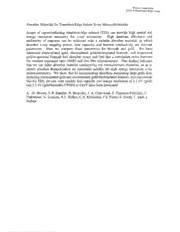
NASA Technical Reports Server (NTRS) 20070036732: Absorber Materials for Transition-Edge Sensor X-ray Microcalorimeters PDF
Preview NASA Technical Reports Server (NTRS) 20070036732: Absorber Materials for Transition-Edge Sensor X-ray Microcalorimeters
Source of Acquisition NASA Goddard Space Flight Center Absorber Materials for Transition-Edge Sensor X-ray Microcalorimeters Arrays of superconducting transition-edge sensors (TES) can provide high spatial and energy resolution necessary for x-ray astronomy. High quantum efficiency and uniformity of response can be achieved with a suitable absorber material, in which absorber x-ray stopping power, heat capacity, and thermal conductivity are relevant parameters. Here we compare these parameters for bismuth and gold. We have fabricated electroplated gold, electroplated gold/electroplated bismuth, and evaporated gold/evaporated bismuth 8x8 absorber arrays and find that a correlation exists between the residual resistance ratio (RRR) and thin film microstructure. This finding indicates that we can tailor absorber material conductivity via microstructure alteration, so as to permit absorber thermalization on timescales suitable for high energy resolution x-ray microcalorimetry. We show that by incorporating absorbers possessing large grain size, including electroplated gold and electroplated gold/electroplated bismuth, into our current MoIAu TES, devices with tunable heat capacity and energy resolution of 2.3 eV (gold) and 2.1 eV (goldhismuth) FWHM at 6 keV have been fabricated. A. -D. Brown, S. R. Bandler, R. Brekosky, J. A. Chervenak, E. Figueroa-Feliciano, F. Finkbeiner, N. Iyomoto, R.L. Kelley, C.A. Kilbourne, F.S. Porter, S. Smith, T. Saab, J. Sadleir I I lorimeters Sadleir, Naoko Iyomoto, Richard Kelley, Electroplated Absorbers: Initial analysis suggests that, when integrated into our detectors, all- Au electroplated absorbers perform much better than evaporated BilAu or BilCu absorbers. 46.85; Bath microns, RRR EP 1 mAkm'; Au: 6 I 5 = = temperature f 50 = Electroplated Au possesses a very low resistivity as compared to evaporated metals (Au, Bi, Cu), and, consequently, should possess vely high the~mal conductivity. a absorber BllAu We observe excesslve broadenrng of the energy curve ofthe spectrum at the lower edge ~f our detectors possess evaporated BdAu absorbers, however, th~s spurtous effect IS not observed when electroplated Au absorbers are used Future Work: Optimizing absorber stem design. * Further characterization of detectors possessing EP Au absorbers. . Employing EP Bi absorbers in our detectorse* Evaporated Elccvoptatcd Bi Bi a k I Materials for Transition-Edge Sensor X-ray Microc Brekosky, James Chervenak, Enectali Figueroa-Feliciano, Fred Finkbeiner, JacCaroline Kilbourne, F. Scott Porter, Stephen Smith, Tarek Saab, Jack Sadleir NASA Goddard Space Flight Center, Greenbelt, MD 20771 I 1 illustrated in this SEM We fabricated absorbers possessing different stem designs, as micrograph, in order to study the effect of different thermal and electronic pathways between the absorber and TES. Different stem designs will also allow us to compare detector performance to different absorber strain. Confocal microscope images illustrate that symmetric (H's and J's) stems have a tendency of being less strained than asymmetric (T's) 1 and stems at sites 3. I 1 @$ Cantilevered We have been able to fabricate arrays mechanically robust absorber possessing a filling fraction of 95- Cross section SEM images 97%. cantilevered- show the absence of absorber bending, which insures that our absorber will not sholt out the TES. Absorber Ari-David Brown', Simon Bandler, Regis Introduction: An integral component of an x-ray calorimeter is an x-ray absorber. In order to achieve optimal calorimeter performance, the absorber must possess low heat egciency These three capacity, high thermal conductance, and high quantum parameters can be tuned by judicious selection of absorber materials and design. In this study, we have developed a generic methodology for fabricating 8x8 cantilevered absorber arrays that can be integrated into our MoIAu transition edge sensors and is compatible with physical vapor deposition and electrochemical deposition. Thus, this methodology allows us to employ a wide variety of absorber materials so that we may freely probe parameter space, and, ultimately, optimize detector performance Here, we examine the molphology and mechanical robustness of evaporated BilAu, BilCu, and electroplated Au cantilevered absorbers and discuss their utility in tern / Absorber Fabrication Methodology: with TES and Au bars grown atop Si,N, coated Si wafer b. Pattem Start a. Deposit absorber metal. Pattern absorber absorber stem with photoresist. d. c. e. pixels with photoresist. Ion mill to separate pixels f. Dissolve photoresist. green, Our absorber stem, highlighted in were grown atop Au "landing pads", in blue, and cantilevered over the TES, in fI
